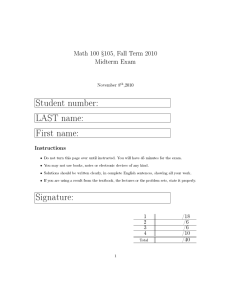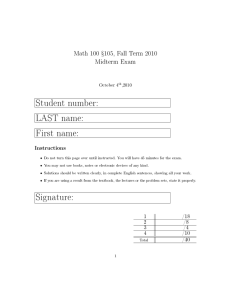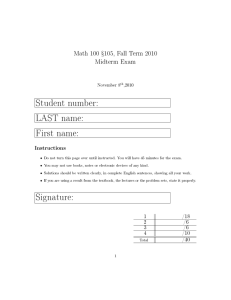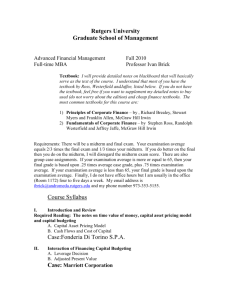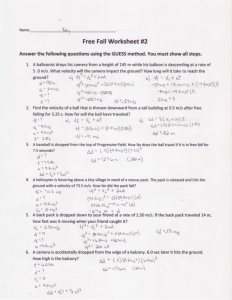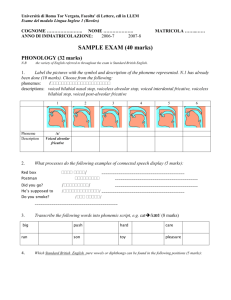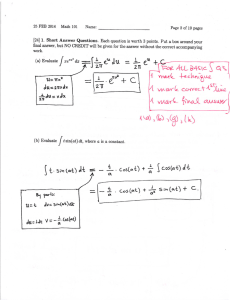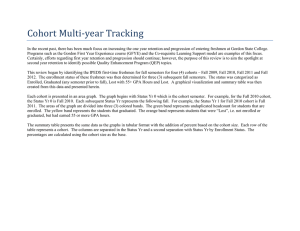Mathematics 226 Midterm 2 – Sample, Fall 2014 Page 1 of 5
advertisement
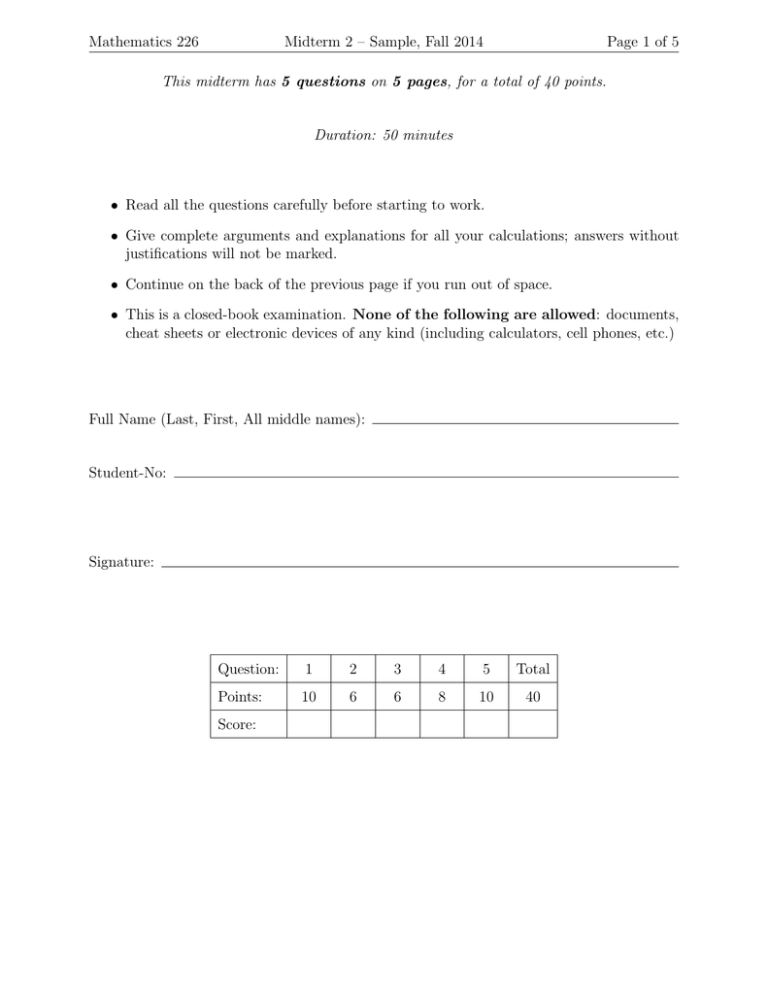
Mathematics 226
Midterm 2 – Sample, Fall 2014
Page 1 of 5
This midterm has 5 questions on 5 pages, for a total of 40 points.
Duration: 50 minutes
• Read all the questions carefully before starting to work.
• Give complete arguments and explanations for all your calculations; answers without
justifications will not be marked.
• Continue on the back of the previous page if you run out of space.
• This is a closed-book examination. None of the following are allowed: documents,
cheat sheets or electronic devices of any kind (including calculators, cell phones, etc.)
Full Name (Last, First, All middle names):
Student-No:
Signature:
Question:
1
2
3
4
5
Total
Points:
10
6
6
8
10
40
Score:
Mathematics 226
10 marks
Midterm 2 – Sample, Fall 2014
Page 2 of 5
1. (a) Let
x5
f (x, y) = x4 + y 4
0
if (x, y) 6= (0, 0)
if (x, y) = (0, 0)
Find the general formula for Du f (0, 0), where u = (u1 , u2 ) is a unit vector, in terms
of u1 , u2 .
Solution:
1 tu5
u51
1
1
t5 u51
1
−
0
=
=
.
Du f (0, 0) = lim (f (tu) − f (0, 0)) =
t→0 t
t t4 u41 + t4 u42
t u41 + u42
u41 + u42
(b) Is there a differentiable function f : R2 → R such that Du f (0, 0) = u21 − u22 for every
unit vector u = (u1 , u2 )? If yes, find it. If no, explain why.
Solution:
If there were such a function, we would have fx (0, 0) = Di f (0, 0) = 12 − 02 = 1
and fy (0, 0) = Dj f (0, 0) = 02 − 12 = −1, hence ∇f (0, 0) = (1, −1). We would
also have Du f (0, 0) = ∇f (0, 0) · u = u1 − u2 for all u. But this is not consistent
with Du f (0, 0) = u21 − u22 : for example when u = −i, the first formula gives
D−i f (0, 0) = −1 − 0 = −1 and the second one gives D−i f (0, 0) = 12 − 02 = 1.
there is no such function.
Mathematics 226
6 marks
Midterm 2 – Sample, Fall 2014
Page 3 of 5
2. Let w = f (a1 x + a2 y + a3 z, b1 x + b2 y + b3 z), where f : R2 → R has continuous first order
partial derivatives. Prove that
c1
∂w
∂w
∂w
+ c2
+ c3
=0
∂x
∂y
∂z
for any vector (c1 , c2 , c3 ) orthogonal to both (a1 , a2 , a3 ) and (b1 , b2 , b3 ).
Solution:
We have w = f (u, v), where u = a1 x + a2 y + a3 z and v = b1 x + b2 y + b3 z. By the
Chain Rule,
c1
∂w
∂w
∂w
+ c2
+ c3
= c1 (fu a1 + fv b1 ) + c2 (fu a2 + fv b2 ) + c3 (fu a3 + fv b3 )
∂x
∂y
∂z
= (c1 a1 + c2 a2 + c3 a3 )fu + (c1 b1 + c2 b2 + c3 b3 )fv = (c · a)fu + (c · b)fv = 0.
6 marks
3. Assume that f : R2 → R is a C 1 function and that the point (1, 2, −3) lies on the
surface f (2x − y + z, x − z) = 10. What condition should f satisfy so that the equation
f (2x − y + z, x − z) = 10 could be solved for z as a differentiable function of x and y
near the point (1, 2, −3)? (Use the Implicit Function Theorem.)
Solution: By the Implicit Function Theorem, we can solve for z as required if
∂z f (2x−y+z, x−z) 6= 0 at (1, 2, −3). As in (a), we have ∂z f (2x−y+z, x−z) = fu −fv .
Also, at (1, 2, −3) we have u = 2 − 2 − 3 = −3 and v = 1 + 3 = 4. Hence the needed
condition is fu (−3, 4) − fv (−3, 4) 6= 0.
Mathematics 226
8 marks
Midterm 2 – Sample, Fall 2014
Page 4 of 5
4. Find the second order Taylor polynomial of the function f (x, y) = sin(x + y 2 ) at (π, 0).
Solution:
f (π, 0) = sin π = 0,
fx (x, y) = cos(x + y 2 ), fx (π, 0) = cos π = −1,
fy (x, y) = 2y cos(x + y 2 ), fx (π, 0) = 0,
fxx (x, y) = − sin(x + y 2 ), fxx (π, 0) = − sin π = 0,
fxy (x, y) = −2y sin(x + y 2 ), fxy (π, 0) = 0,
fyy (x, y) = −4y 2 sin(x + y 2 ) + 2 cos(x + y 2 ), fyy (π, 0) = 2 cos π = −2,
p2 (x, y) = −(x − π) − y 2 .
Mathematics 226
10 marks
Midterm 2 – Sample, Fall 2014
Page 5 of 5
5. Find the largest and smallest values of the function f (x, y) = 4x − 2xy + y 2 on the square
{(x, y) : 0 ≤ x ≤ 2, 0 ≤ y ≤ 2}.
Solution: We first look for critical points inside the region. We have fx = 4 − 2y
and fy = −2x + 2y, hence if fx = fy = 0, then y = 2 and x = 2. At the critical point,
f (2, 2) = 8 − 8 + 4 = 4.
Next, we look for possible minima and maxima on the boundary:
• f (x, 0) = 4x, minimum value on [0, 2] is f (0, 0) = 0, maximum value is f (2, 0) =
8;
• f (x, 2) = 4x − 4x + 4 = 4;
• f (0, y) = y 2 , minimum value on [0, 2] is f (0, 0) = 0, maximum value is f (0, 2) =
4;
• f (2, y) = 8 − 4y + y 2 . To find its extrema on [0, 2], we look for critical points:
−4 + 2y = 0, y = 2. We have already evaluated f (2, 2) = 4 and f (2, 0) = 8.
Thus the smallest value is f (0, 0) = 0 and the largest value is f (2, 0) = 8.
